Prevention of Alcohol Use Among Aboriginal Youths
VerifiedAdded on 2023/01/18
|12
|3370
|91
AI Summary
This health promotion project aims to create awareness about alcohol consumption and prevention among Aboriginal youths. It discusses the target group, aims, prevention strategies, stakeholders, and evaluation.
Contribute Materials
Your contribution can guide someone’s learning journey. Share your
documents today.
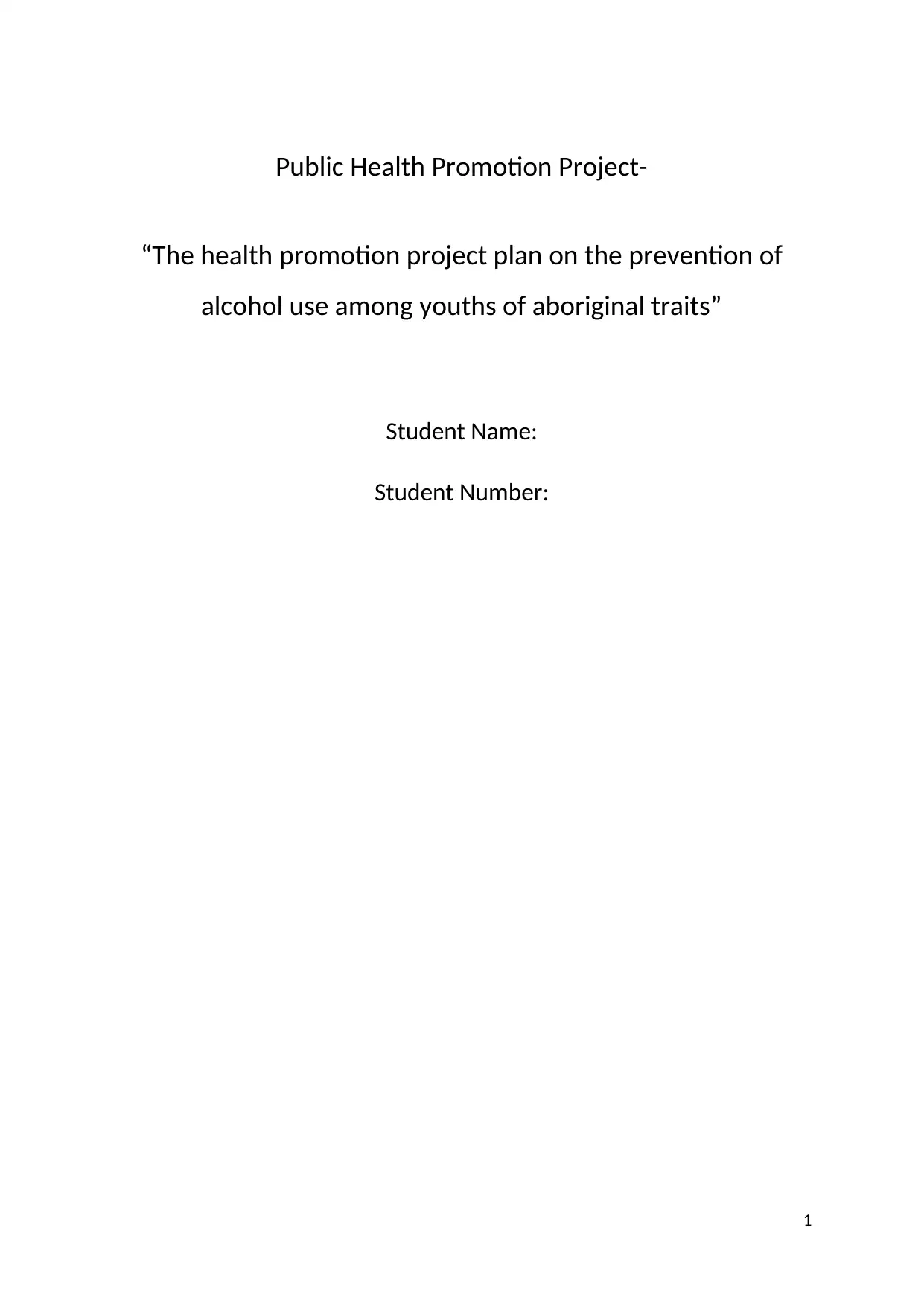
Public Health Promotion Project-
“The health promotion project plan on the prevention of
alcohol use among youths of aboriginal traits”
Student Name:
Student Number:
1
“The health promotion project plan on the prevention of
alcohol use among youths of aboriginal traits”
Student Name:
Student Number:
1
Secure Best Marks with AI Grader
Need help grading? Try our AI Grader for instant feedback on your assignments.
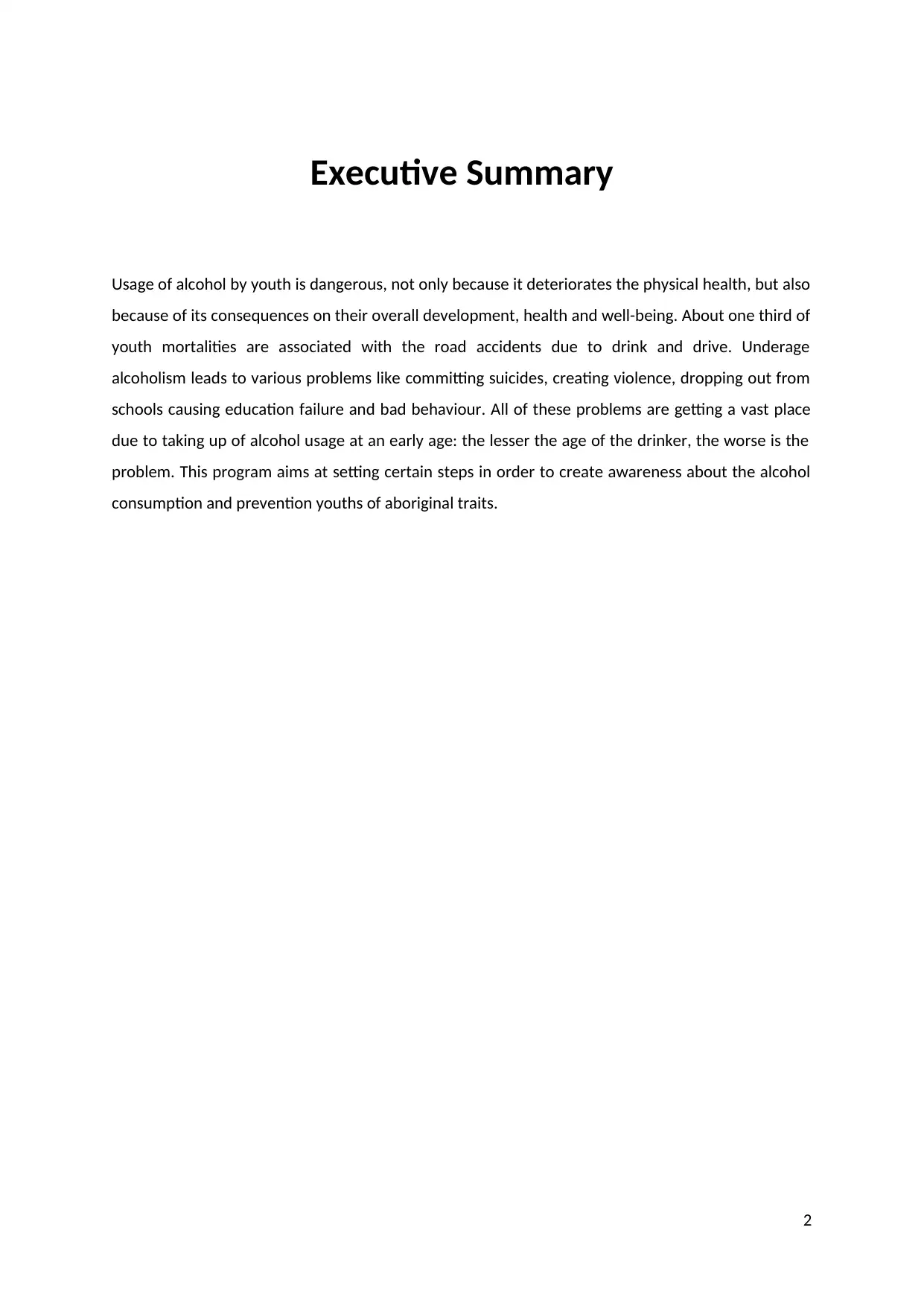
Executive Summary
Usage of alcohol by youth is dangerous, not only because it deteriorates the physical health, but also
because of its consequences on their overall development, health and well-being. About one third of
youth mortalities are associated with the road accidents due to drink and drive. Underage
alcoholism leads to various problems like committing suicides, creating violence, dropping out from
schools causing education failure and bad behaviour. All of these problems are getting a vast place
due to taking up of alcohol usage at an early age: the lesser the age of the drinker, the worse is the
problem. This program aims at setting certain steps in order to create awareness about the alcohol
consumption and prevention youths of aboriginal traits.
2
Usage of alcohol by youth is dangerous, not only because it deteriorates the physical health, but also
because of its consequences on their overall development, health and well-being. About one third of
youth mortalities are associated with the road accidents due to drink and drive. Underage
alcoholism leads to various problems like committing suicides, creating violence, dropping out from
schools causing education failure and bad behaviour. All of these problems are getting a vast place
due to taking up of alcohol usage at an early age: the lesser the age of the drinker, the worse is the
problem. This program aims at setting certain steps in order to create awareness about the alcohol
consumption and prevention youths of aboriginal traits.
2
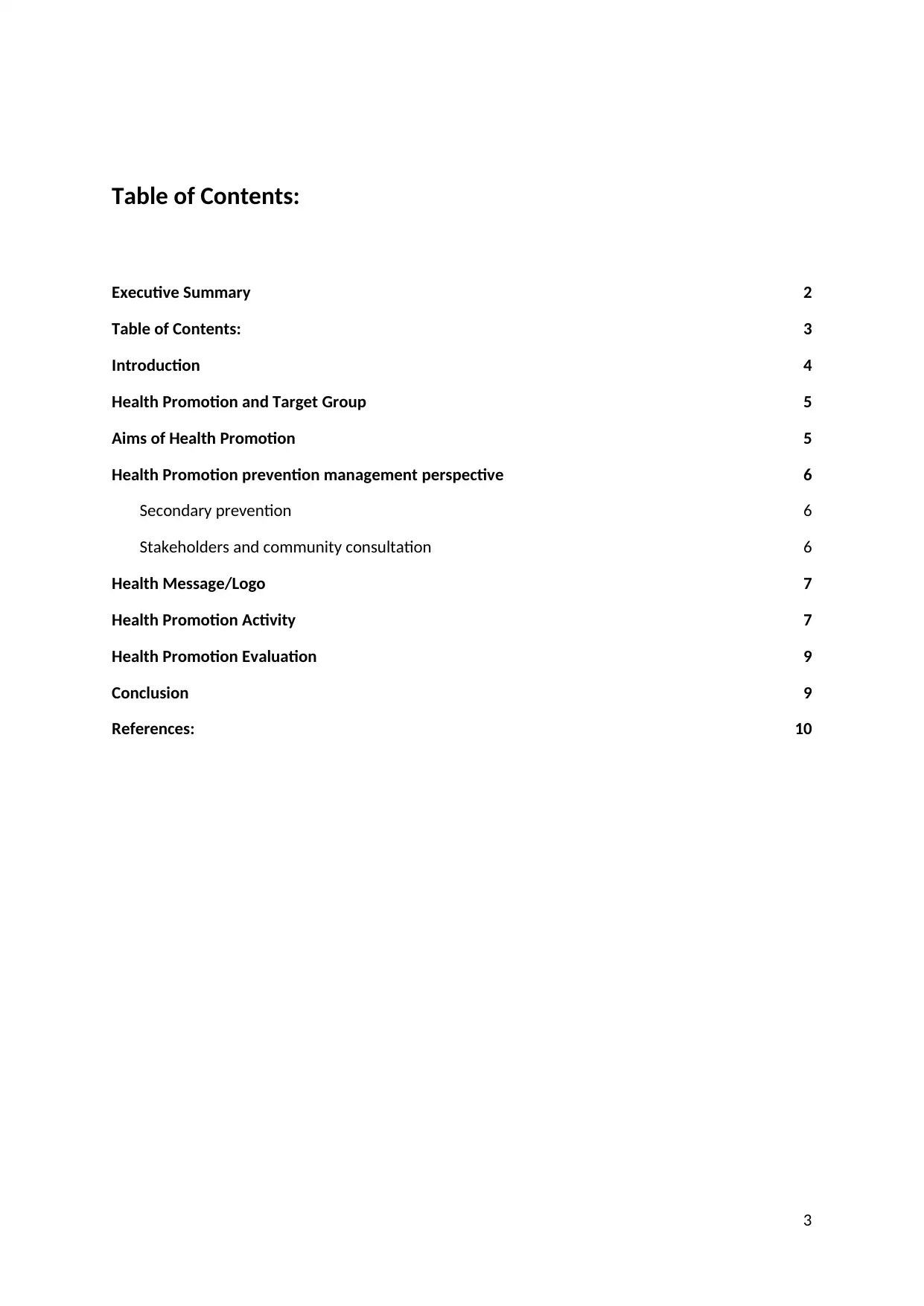
Table of Contents:
Executive Summary 2
Table of Contents: 3
Introduction 4
Health Promotion and Target Group 5
Aims of Health Promotion 5
Health Promotion prevention management perspective 6
Secondary prevention 6
Stakeholders and community consultation 6
Health Message/Logo 7
Health Promotion Activity 7
Health Promotion Evaluation 9
Conclusion 9
References: 10
3
Executive Summary 2
Table of Contents: 3
Introduction 4
Health Promotion and Target Group 5
Aims of Health Promotion 5
Health Promotion prevention management perspective 6
Secondary prevention 6
Stakeholders and community consultation 6
Health Message/Logo 7
Health Promotion Activity 7
Health Promotion Evaluation 9
Conclusion 9
References: 10
3
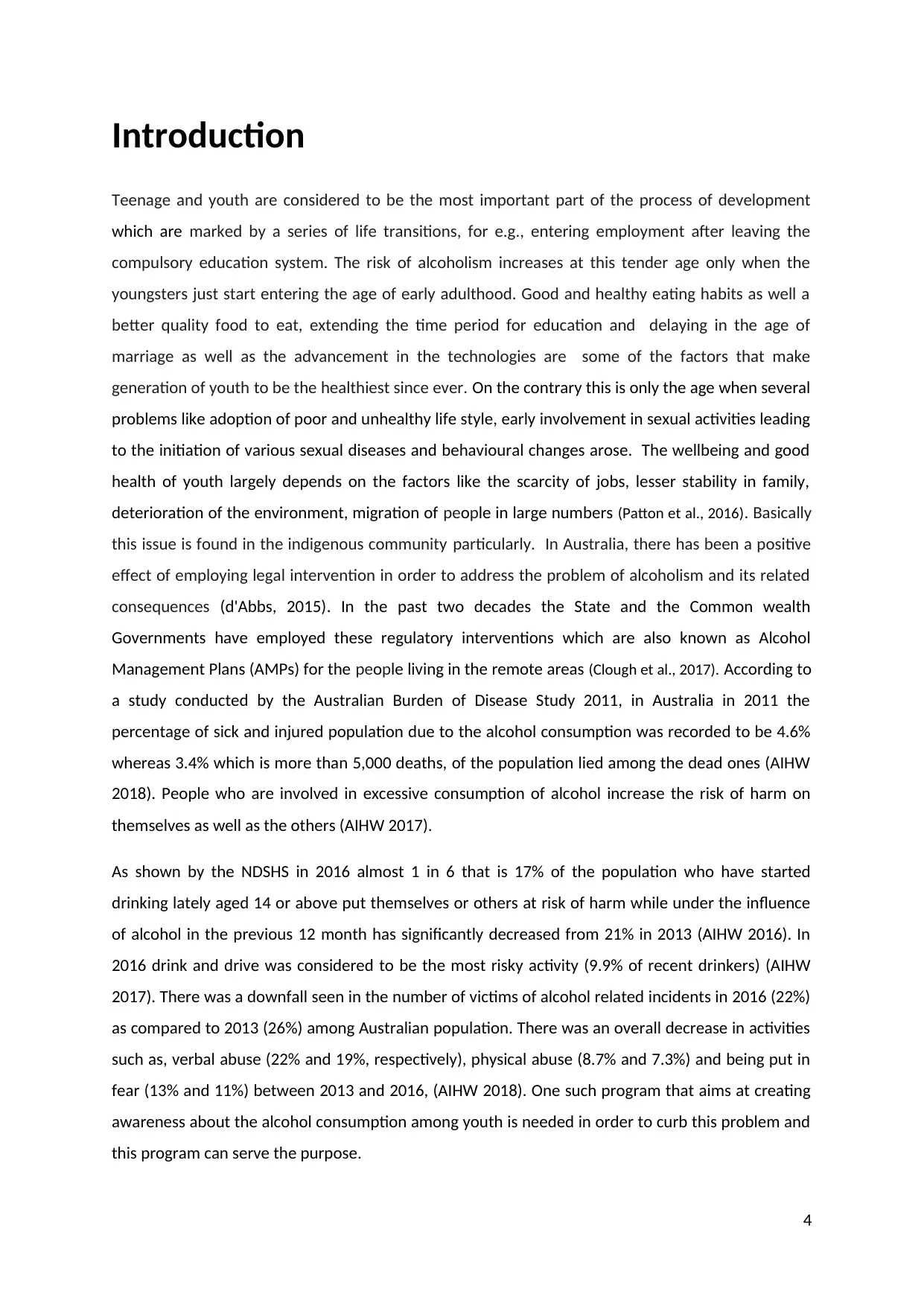
Introduction
Teenage and youth are considered to be the most important part of the process of development
which are marked by a series of life transitions, for e.g., entering employment after leaving the
compulsory education system. The risk of alcoholism increases at this tender age only when the
youngsters just start entering the age of early adulthood. Good and healthy eating habits as well a
better quality food to eat, extending the time period for education and delaying in the age of
marriage as well as the advancement in the technologies are some of the factors that make
generation of youth to be the healthiest since ever. On the contrary this is only the age when several
problems like adoption of poor and unhealthy life style, early involvement in sexual activities leading
to the initiation of various sexual diseases and behavioural changes arose. The wellbeing and good
health of youth largely depends on the factors like the scarcity of jobs, lesser stability in family,
deterioration of the environment, migration of people in large numbers (Patton et al., 2016). Basically
this issue is found in the indigenous community particularly. In Australia, there has been a positive
effect of employing legal intervention in order to address the problem of alcoholism and its related
consequences (d'Abbs, 2015). In the past two decades the State and the Common wealth
Governments have employed these regulatory interventions which are also known as Alcohol
Management Plans (AMPs) for the people living in the remote areas (Clough et al., 2017). According to
a study conducted by the Australian Burden of Disease Study 2011, in Australia in 2011 the
percentage of sick and injured population due to the alcohol consumption was recorded to be 4.6%
whereas 3.4% which is more than 5,000 deaths, of the population lied among the dead ones (AIHW
2018). People who are involved in excessive consumption of alcohol increase the risk of harm on
themselves as well as the others (AIHW 2017).
As shown by the NDSHS in 2016 almost 1 in 6 that is 17% of the population who have started
drinking lately aged 14 or above put themselves or others at risk of harm while under the influence
of alcohol in the previous 12 month has significantly decreased from 21% in 2013 (AIHW 2016). In
2016 drink and drive was considered to be the most risky activity (9.9% of recent drinkers) (AIHW
2017). There was a downfall seen in the number of victims of alcohol related incidents in 2016 (22%)
as compared to 2013 (26%) among Australian population. There was an overall decrease in activities
such as, verbal abuse (22% and 19%, respectively), physical abuse (8.7% and 7.3%) and being put in
fear (13% and 11%) between 2013 and 2016, (AIHW 2018). One such program that aims at creating
awareness about the alcohol consumption among youth is needed in order to curb this problem and
this program can serve the purpose.
4
Teenage and youth are considered to be the most important part of the process of development
which are marked by a series of life transitions, for e.g., entering employment after leaving the
compulsory education system. The risk of alcoholism increases at this tender age only when the
youngsters just start entering the age of early adulthood. Good and healthy eating habits as well a
better quality food to eat, extending the time period for education and delaying in the age of
marriage as well as the advancement in the technologies are some of the factors that make
generation of youth to be the healthiest since ever. On the contrary this is only the age when several
problems like adoption of poor and unhealthy life style, early involvement in sexual activities leading
to the initiation of various sexual diseases and behavioural changes arose. The wellbeing and good
health of youth largely depends on the factors like the scarcity of jobs, lesser stability in family,
deterioration of the environment, migration of people in large numbers (Patton et al., 2016). Basically
this issue is found in the indigenous community particularly. In Australia, there has been a positive
effect of employing legal intervention in order to address the problem of alcoholism and its related
consequences (d'Abbs, 2015). In the past two decades the State and the Common wealth
Governments have employed these regulatory interventions which are also known as Alcohol
Management Plans (AMPs) for the people living in the remote areas (Clough et al., 2017). According to
a study conducted by the Australian Burden of Disease Study 2011, in Australia in 2011 the
percentage of sick and injured population due to the alcohol consumption was recorded to be 4.6%
whereas 3.4% which is more than 5,000 deaths, of the population lied among the dead ones (AIHW
2018). People who are involved in excessive consumption of alcohol increase the risk of harm on
themselves as well as the others (AIHW 2017).
As shown by the NDSHS in 2016 almost 1 in 6 that is 17% of the population who have started
drinking lately aged 14 or above put themselves or others at risk of harm while under the influence
of alcohol in the previous 12 month has significantly decreased from 21% in 2013 (AIHW 2016). In
2016 drink and drive was considered to be the most risky activity (9.9% of recent drinkers) (AIHW
2017). There was a downfall seen in the number of victims of alcohol related incidents in 2016 (22%)
as compared to 2013 (26%) among Australian population. There was an overall decrease in activities
such as, verbal abuse (22% and 19%, respectively), physical abuse (8.7% and 7.3%) and being put in
fear (13% and 11%) between 2013 and 2016, (AIHW 2018). One such program that aims at creating
awareness about the alcohol consumption among youth is needed in order to curb this problem and
this program can serve the purpose.
4
Secure Best Marks with AI Grader
Need help grading? Try our AI Grader for instant feedback on your assignments.
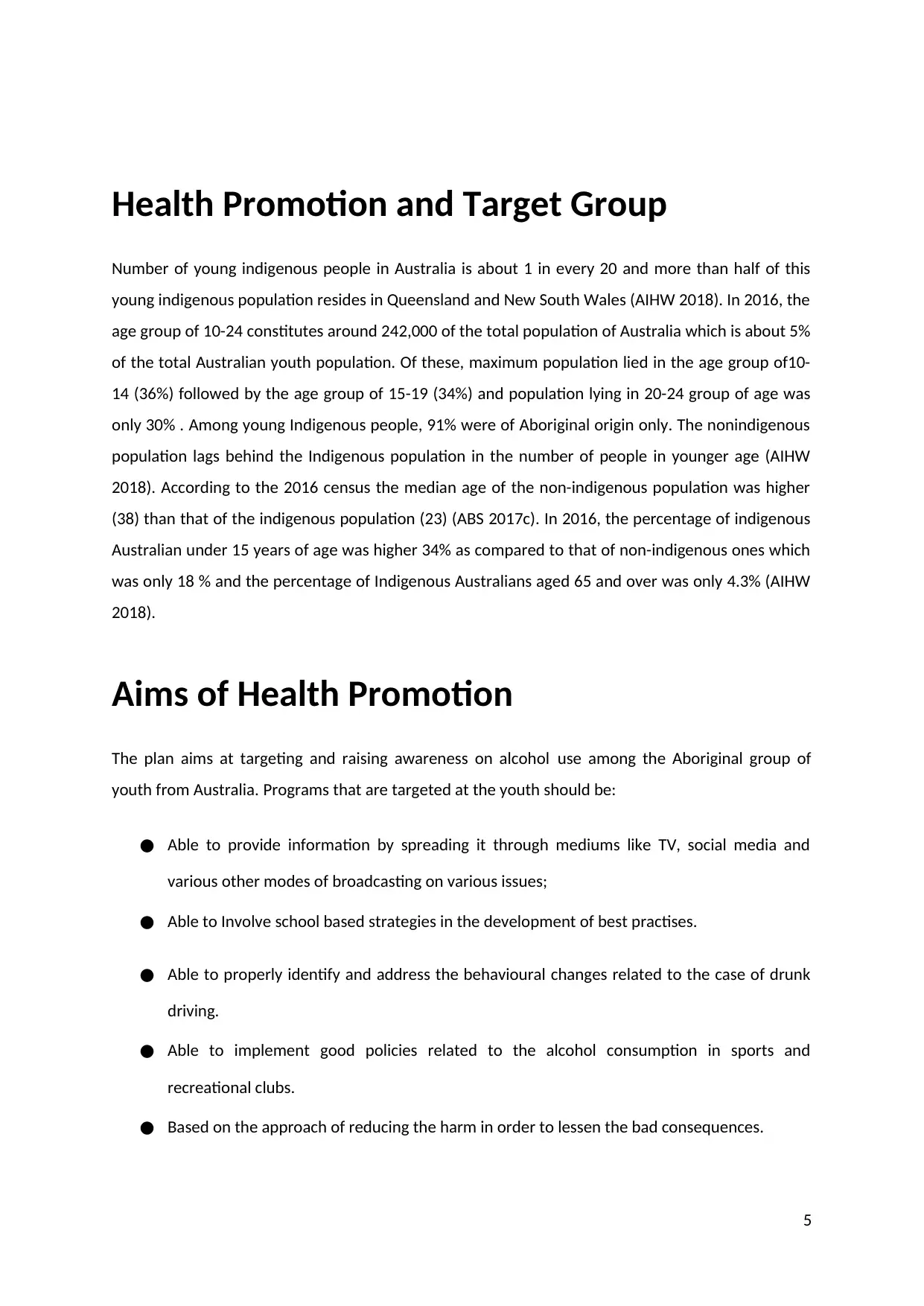
Health Promotion and Target Group
Number of young indigenous people in Australia is about 1 in every 20 and more than half of this
young indigenous population resides in Queensland and New South Wales (AIHW 2018). In 2016, the
age group of 10-24 constitutes around 242,000 of the total population of Australia which is about 5%
of the total Australian youth population. Of these, maximum population lied in the age group of10-
14 (36%) followed by the age group of 15-19 (34%) and population lying in 20-24 group of age was
only 30% . Among young Indigenous people, 91% were of Aboriginal origin only. The nonindigenous
population lags behind the Indigenous population in the number of people in younger age (AIHW
2018). According to the 2016 census the median age of the non-indigenous population was higher
(38) than that of the indigenous population (23) (ABS 2017c). In 2016, the percentage of indigenous
Australian under 15 years of age was higher 34% as compared to that of non-indigenous ones which
was only 18 % and the percentage of Indigenous Australians aged 65 and over was only 4.3% (AIHW
2018).
Aims of Health Promotion
The plan aims at targeting and raising awareness on alcohol use among the Aboriginal group of
youth from Australia. Programs that are targeted at the youth should be:
● Able to provide information by spreading it through mediums like TV, social media and
various other modes of broadcasting on various issues;
● Able to Involve school based strategies in the development of best practises.
● Able to properly identify and address the behavioural changes related to the case of drunk
driving.
● Able to implement good policies related to the alcohol consumption in sports and
recreational clubs.
● Based on the approach of reducing the harm in order to lessen the bad consequences.
5
Number of young indigenous people in Australia is about 1 in every 20 and more than half of this
young indigenous population resides in Queensland and New South Wales (AIHW 2018). In 2016, the
age group of 10-24 constitutes around 242,000 of the total population of Australia which is about 5%
of the total Australian youth population. Of these, maximum population lied in the age group of10-
14 (36%) followed by the age group of 15-19 (34%) and population lying in 20-24 group of age was
only 30% . Among young Indigenous people, 91% were of Aboriginal origin only. The nonindigenous
population lags behind the Indigenous population in the number of people in younger age (AIHW
2018). According to the 2016 census the median age of the non-indigenous population was higher
(38) than that of the indigenous population (23) (ABS 2017c). In 2016, the percentage of indigenous
Australian under 15 years of age was higher 34% as compared to that of non-indigenous ones which
was only 18 % and the percentage of Indigenous Australians aged 65 and over was only 4.3% (AIHW
2018).
Aims of Health Promotion
The plan aims at targeting and raising awareness on alcohol use among the Aboriginal group of
youth from Australia. Programs that are targeted at the youth should be:
● Able to provide information by spreading it through mediums like TV, social media and
various other modes of broadcasting on various issues;
● Able to Involve school based strategies in the development of best practises.
● Able to properly identify and address the behavioural changes related to the case of drunk
driving.
● Able to implement good policies related to the alcohol consumption in sports and
recreational clubs.
● Based on the approach of reducing the harm in order to lessen the bad consequences.
5
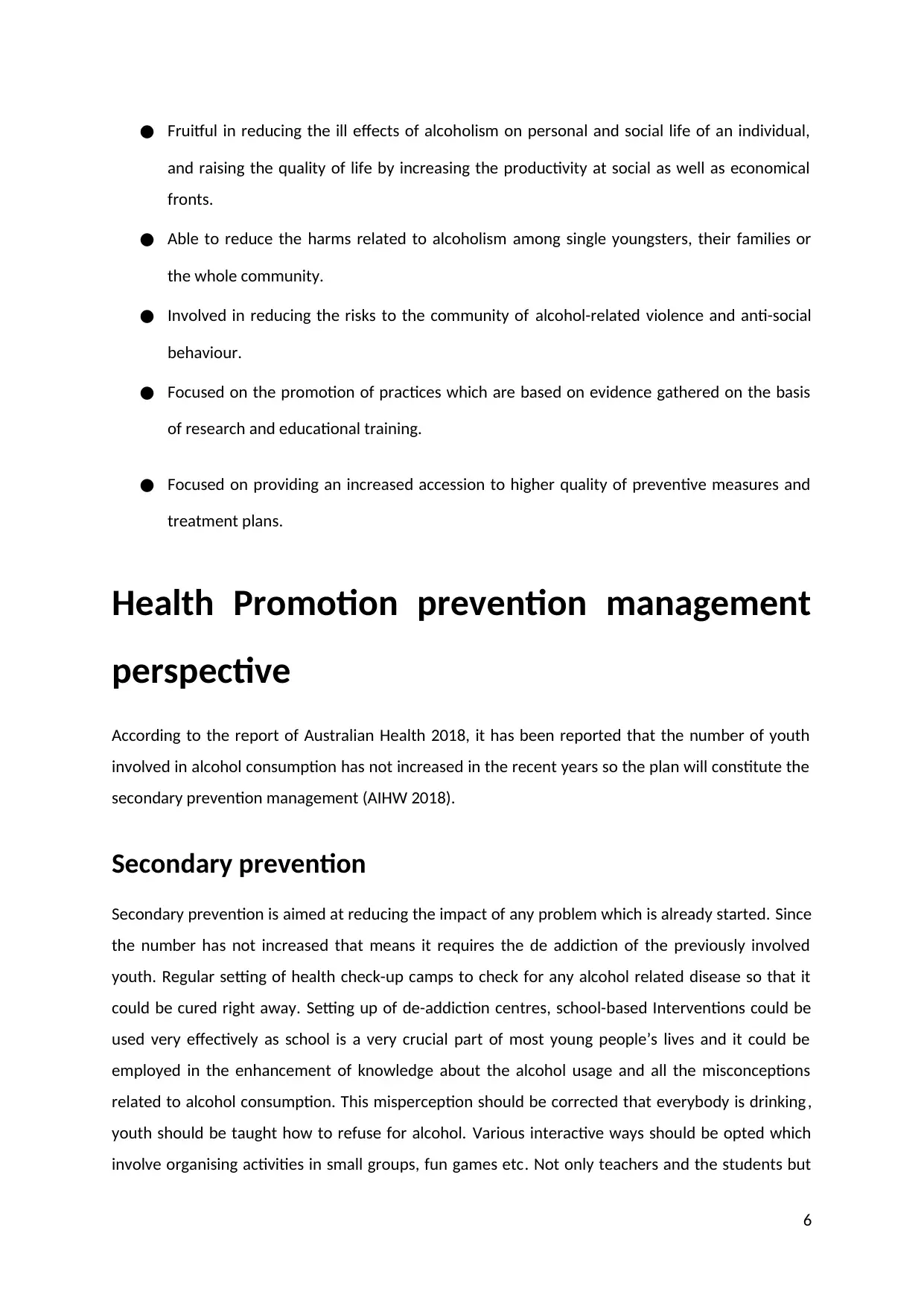
● Fruitful in reducing the ill effects of alcoholism on personal and social life of an individual,
and raising the quality of life by increasing the productivity at social as well as economical
fronts.
● Able to reduce the harms related to alcoholism among single youngsters, their families or
the whole community.
● Involved in reducing the risks to the community of alcohol-related violence and anti-social
behaviour.
● Focused on the promotion of practices which are based on evidence gathered on the basis
of research and educational training.
● Focused on providing an increased accession to higher quality of preventive measures and
treatment plans.
Health Promotion prevention management
perspective
According to the report of Australian Health 2018, it has been reported that the number of youth
involved in alcohol consumption has not increased in the recent years so the plan will constitute the
secondary prevention management (AIHW 2018).
Secondary prevention
Secondary prevention is aimed at reducing the impact of any problem which is already started. Since
the number has not increased that means it requires the de addiction of the previously involved
youth. Regular setting of health check-up camps to check for any alcohol related disease so that it
could be cured right away. Setting up of de-addiction centres, school-based Interventions could be
used very effectively as school is a very crucial part of most young people’s lives and it could be
employed in the enhancement of knowledge about the alcohol usage and all the misconceptions
related to alcohol consumption. This misperception should be corrected that everybody is drinking,
youth should be taught how to refuse for alcohol. Various interactive ways should be opted which
involve organising activities in small groups, fun games etc. Not only teachers and the students but
6
and raising the quality of life by increasing the productivity at social as well as economical
fronts.
● Able to reduce the harms related to alcoholism among single youngsters, their families or
the whole community.
● Involved in reducing the risks to the community of alcohol-related violence and anti-social
behaviour.
● Focused on the promotion of practices which are based on evidence gathered on the basis
of research and educational training.
● Focused on providing an increased accession to higher quality of preventive measures and
treatment plans.
Health Promotion prevention management
perspective
According to the report of Australian Health 2018, it has been reported that the number of youth
involved in alcohol consumption has not increased in the recent years so the plan will constitute the
secondary prevention management (AIHW 2018).
Secondary prevention
Secondary prevention is aimed at reducing the impact of any problem which is already started. Since
the number has not increased that means it requires the de addiction of the previously involved
youth. Regular setting of health check-up camps to check for any alcohol related disease so that it
could be cured right away. Setting up of de-addiction centres, school-based Interventions could be
used very effectively as school is a very crucial part of most young people’s lives and it could be
employed in the enhancement of knowledge about the alcohol usage and all the misconceptions
related to alcohol consumption. This misperception should be corrected that everybody is drinking,
youth should be taught how to refuse for alcohol. Various interactive ways should be opted which
involve organising activities in small groups, fun games etc. Not only teachers and the students but
6
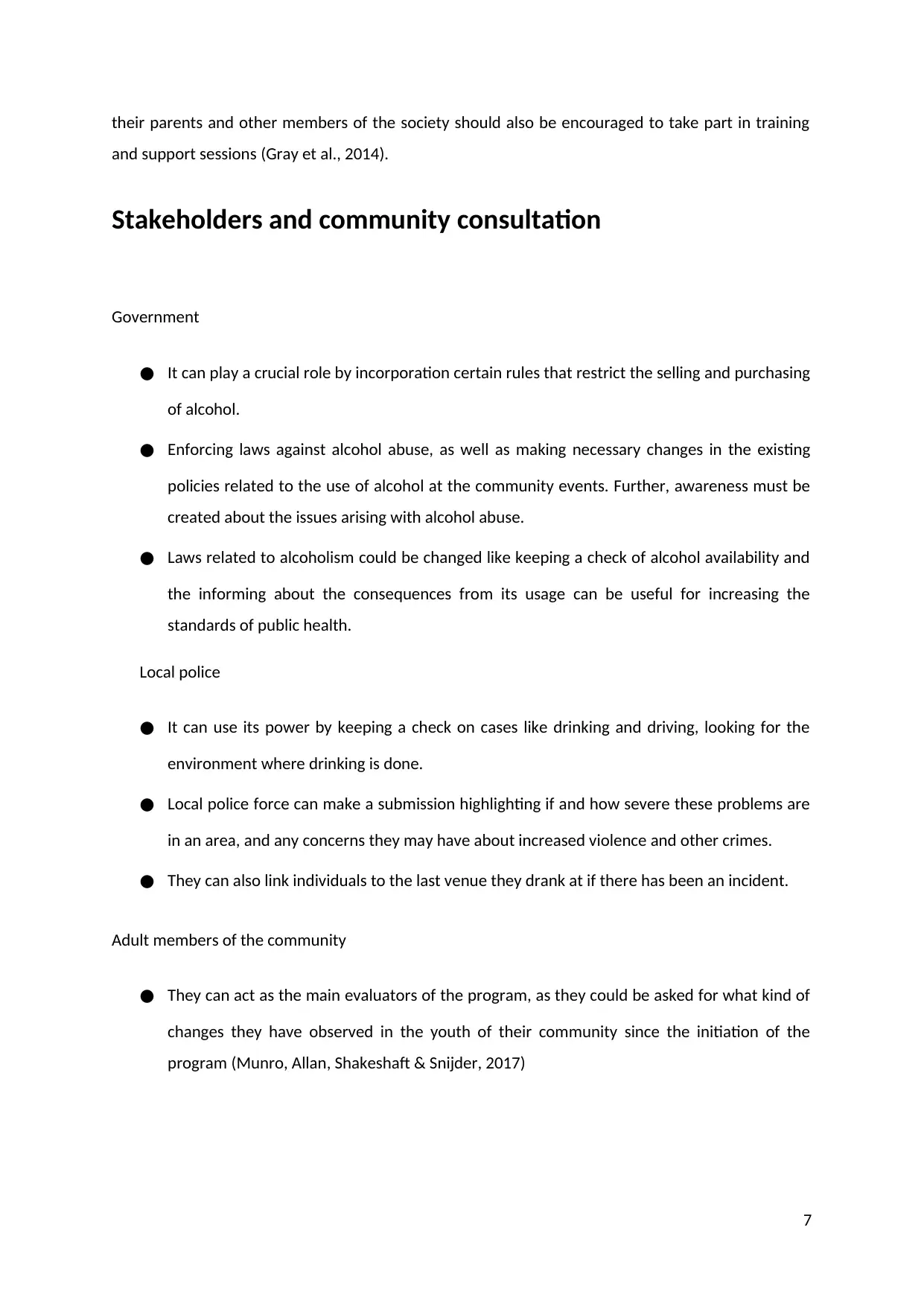
their parents and other members of the society should also be encouraged to take part in training
and support sessions (Gray et al., 2014).
Stakeholders and community consultation
Government
● It can play a crucial role by incorporation certain rules that restrict the selling and purchasing
of alcohol.
● Enforcing laws against alcohol abuse, as well as making necessary changes in the existing
policies related to the use of alcohol at the community events. Further, awareness must be
created about the issues arising with alcohol abuse.
● Laws related to alcoholism could be changed like keeping a check of alcohol availability and
the informing about the consequences from its usage can be useful for increasing the
standards of public health.
Local police
● It can use its power by keeping a check on cases like drinking and driving, looking for the
environment where drinking is done.
● Local police force can make a submission highlighting if and how severe these problems are
in an area, and any concerns they may have about increased violence and other crimes.
● They can also link individuals to the last venue they drank at if there has been an incident.
Adult members of the community
● They can act as the main evaluators of the program, as they could be asked for what kind of
changes they have observed in the youth of their community since the initiation of the
program (Munro, Allan, Shakeshaft & Snijder, 2017)
7
and support sessions (Gray et al., 2014).
Stakeholders and community consultation
Government
● It can play a crucial role by incorporation certain rules that restrict the selling and purchasing
of alcohol.
● Enforcing laws against alcohol abuse, as well as making necessary changes in the existing
policies related to the use of alcohol at the community events. Further, awareness must be
created about the issues arising with alcohol abuse.
● Laws related to alcoholism could be changed like keeping a check of alcohol availability and
the informing about the consequences from its usage can be useful for increasing the
standards of public health.
Local police
● It can use its power by keeping a check on cases like drinking and driving, looking for the
environment where drinking is done.
● Local police force can make a submission highlighting if and how severe these problems are
in an area, and any concerns they may have about increased violence and other crimes.
● They can also link individuals to the last venue they drank at if there has been an incident.
Adult members of the community
● They can act as the main evaluators of the program, as they could be asked for what kind of
changes they have observed in the youth of their community since the initiation of the
program (Munro, Allan, Shakeshaft & Snijder, 2017)
7
Paraphrase This Document
Need a fresh take? Get an instant paraphrase of this document with our AI Paraphraser

Health Message/Logo
Live, Laugh, Love….Alcohol, Disease, Death…Choice is yours!
Health Promotion Activity
The following activities would be taken into consideration
1. Capacity building – providing better and targeted responses to alcoholism and it’s the
problems associated with it through capacity building, collaborating with the youngsters,
development of work force , practice based on evidence, observing and distributing the
information
2. Preventive measures should be focused – enhancing the knowledge of youth and their
families on how to get encouraged and develop good quality of life that is free from any kind
of alcohol abuse or its adverse effects.
3. Effective treatment and support – providing proper support by employing various research
and evaluation data on treatment in order to make it easier for the youth which is suffering
from crisis due to alcohol usage of its own or any other person like them.
4. Intervening before the problem gets rooted much deeper– identifying individuals or families
which are at risk and execute various programs that work for increasing their knowledge on
alcohol consumptions and its consequences.
5. Approaches of that involve the enforcement of effective law– minimizing and regulating the
availability of alcohol to the minors and executing policies that aims at preventing or
breaking the offending cycle.
6. Involving work places – Work places are very crucial part of creating awareness, variety of
people could be dealt with in a single point of time. They will in turn act as the elements for
the flow of information to their respective homes.
7. Family Interventions – Following steps have been devised from various research and
evaluations done previously and are proven to be very useful in inculcating good habits and
making the youth learn about the ill effects of alcoholism and how to stay away or delay its
consumption:
a) The parents should participate actively in all the events or interactions organised by the
schools of their children.
8
Live, Laugh, Love….Alcohol, Disease, Death…Choice is yours!
Health Promotion Activity
The following activities would be taken into consideration
1. Capacity building – providing better and targeted responses to alcoholism and it’s the
problems associated with it through capacity building, collaborating with the youngsters,
development of work force , practice based on evidence, observing and distributing the
information
2. Preventive measures should be focused – enhancing the knowledge of youth and their
families on how to get encouraged and develop good quality of life that is free from any kind
of alcohol abuse or its adverse effects.
3. Effective treatment and support – providing proper support by employing various research
and evaluation data on treatment in order to make it easier for the youth which is suffering
from crisis due to alcohol usage of its own or any other person like them.
4. Intervening before the problem gets rooted much deeper– identifying individuals or families
which are at risk and execute various programs that work for increasing their knowledge on
alcohol consumptions and its consequences.
5. Approaches of that involve the enforcement of effective law– minimizing and regulating the
availability of alcohol to the minors and executing policies that aims at preventing or
breaking the offending cycle.
6. Involving work places – Work places are very crucial part of creating awareness, variety of
people could be dealt with in a single point of time. They will in turn act as the elements for
the flow of information to their respective homes.
7. Family Interventions – Following steps have been devised from various research and
evaluations done previously and are proven to be very useful in inculcating good habits and
making the youth learn about the ill effects of alcoholism and how to stay away or delay its
consumption:
a) The parents should participate actively in all the events or interactions organised by the
schools of their children.
8

b) Should involve their children in activities such as outings, picnics, fun games and
encourage alternatives to alcohol use.
c) Families should encourage the involvement of their children in making bonds with their
communities from a very young age by enrolling them into various games and other fun
and recreational activities.
d) There should be a proper and transparent discussion about the usage of alcohol and its
consequences.
e) They should set some rules for the family and talk about the consequences of breaking
the same, also they should make themselves very clear in front of their children as to
why they are making these rules and how they will be beneficial for them.
f) Parents should avoid communication of their ideas when the child is in a state of
frustration or there is a sudden outburst of anger as this could even worsen the
situation.
g) The family should know the accurate time and space to start any conversation or making
any point with their children (Calabria, Clifford, Rose & Shakeshaft, 2014).
Apart from the above points these points could also be taken into consideration
● The program should be able to provide all the necessary information about a healthy life and
also the adverse effects of alcohol consumption on society as well as on one’s own life.
● The program should be able to strengthen the skill of an individual at personal as well as
social level.
● It should encourage the youth to develop a healthy relationship with their family or with
every other person who is above their age
● It should be able to come up with solutions like, how to get a good job, by having quality
education, vocational trainings etc.
● The program should involve fun and light modes of interaction in order to make the process
of understanding enjoyable for youth thereby enhancing their constructive knowledge.
● Keeping a check on how much alcohol is there in any area which is available easily.
● Raising awareness of the problem of alcohol usage in the community.
9
encourage alternatives to alcohol use.
c) Families should encourage the involvement of their children in making bonds with their
communities from a very young age by enrolling them into various games and other fun
and recreational activities.
d) There should be a proper and transparent discussion about the usage of alcohol and its
consequences.
e) They should set some rules for the family and talk about the consequences of breaking
the same, also they should make themselves very clear in front of their children as to
why they are making these rules and how they will be beneficial for them.
f) Parents should avoid communication of their ideas when the child is in a state of
frustration or there is a sudden outburst of anger as this could even worsen the
situation.
g) The family should know the accurate time and space to start any conversation or making
any point with their children (Calabria, Clifford, Rose & Shakeshaft, 2014).
Apart from the above points these points could also be taken into consideration
● The program should be able to provide all the necessary information about a healthy life and
also the adverse effects of alcohol consumption on society as well as on one’s own life.
● The program should be able to strengthen the skill of an individual at personal as well as
social level.
● It should encourage the youth to develop a healthy relationship with their family or with
every other person who is above their age
● It should be able to come up with solutions like, how to get a good job, by having quality
education, vocational trainings etc.
● The program should involve fun and light modes of interaction in order to make the process
of understanding enjoyable for youth thereby enhancing their constructive knowledge.
● Keeping a check on how much alcohol is there in any area which is available easily.
● Raising awareness of the problem of alcohol usage in the community.
9
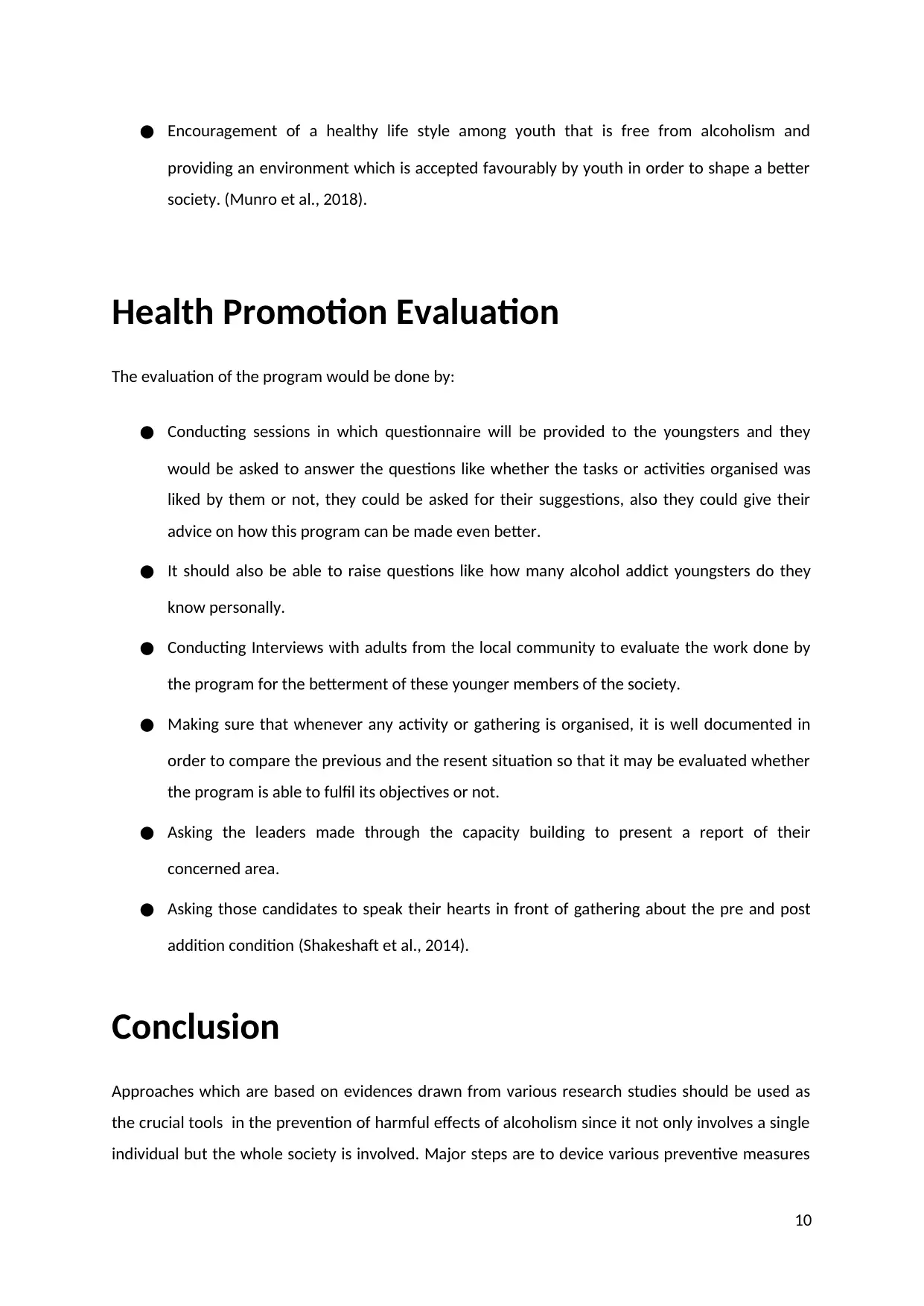
● Encouragement of a healthy life style among youth that is free from alcoholism and
providing an environment which is accepted favourably by youth in order to shape a better
society. (Munro et al., 2018).
Health Promotion Evaluation
The evaluation of the program would be done by:
● Conducting sessions in which questionnaire will be provided to the youngsters and they
would be asked to answer the questions like whether the tasks or activities organised was
liked by them or not, they could be asked for their suggestions, also they could give their
advice on how this program can be made even better.
● It should also be able to raise questions like how many alcohol addict youngsters do they
know personally.
● Conducting Interviews with adults from the local community to evaluate the work done by
the program for the betterment of these younger members of the society.
● Making sure that whenever any activity or gathering is organised, it is well documented in
order to compare the previous and the resent situation so that it may be evaluated whether
the program is able to fulfil its objectives or not.
● Asking the leaders made through the capacity building to present a report of their
concerned area.
● Asking those candidates to speak their hearts in front of gathering about the pre and post
addition condition (Shakeshaft et al., 2014).
Conclusion
Approaches which are based on evidences drawn from various research studies should be used as
the crucial tools in the prevention of harmful effects of alcoholism since it not only involves a single
individual but the whole society is involved. Major steps are to device various preventive measures
10
providing an environment which is accepted favourably by youth in order to shape a better
society. (Munro et al., 2018).
Health Promotion Evaluation
The evaluation of the program would be done by:
● Conducting sessions in which questionnaire will be provided to the youngsters and they
would be asked to answer the questions like whether the tasks or activities organised was
liked by them or not, they could be asked for their suggestions, also they could give their
advice on how this program can be made even better.
● It should also be able to raise questions like how many alcohol addict youngsters do they
know personally.
● Conducting Interviews with adults from the local community to evaluate the work done by
the program for the betterment of these younger members of the society.
● Making sure that whenever any activity or gathering is organised, it is well documented in
order to compare the previous and the resent situation so that it may be evaluated whether
the program is able to fulfil its objectives or not.
● Asking the leaders made through the capacity building to present a report of their
concerned area.
● Asking those candidates to speak their hearts in front of gathering about the pre and post
addition condition (Shakeshaft et al., 2014).
Conclusion
Approaches which are based on evidences drawn from various research studies should be used as
the crucial tools in the prevention of harmful effects of alcoholism since it not only involves a single
individual but the whole society is involved. Major steps are to device various preventive measures
10
Secure Best Marks with AI Grader
Need help grading? Try our AI Grader for instant feedback on your assignments.
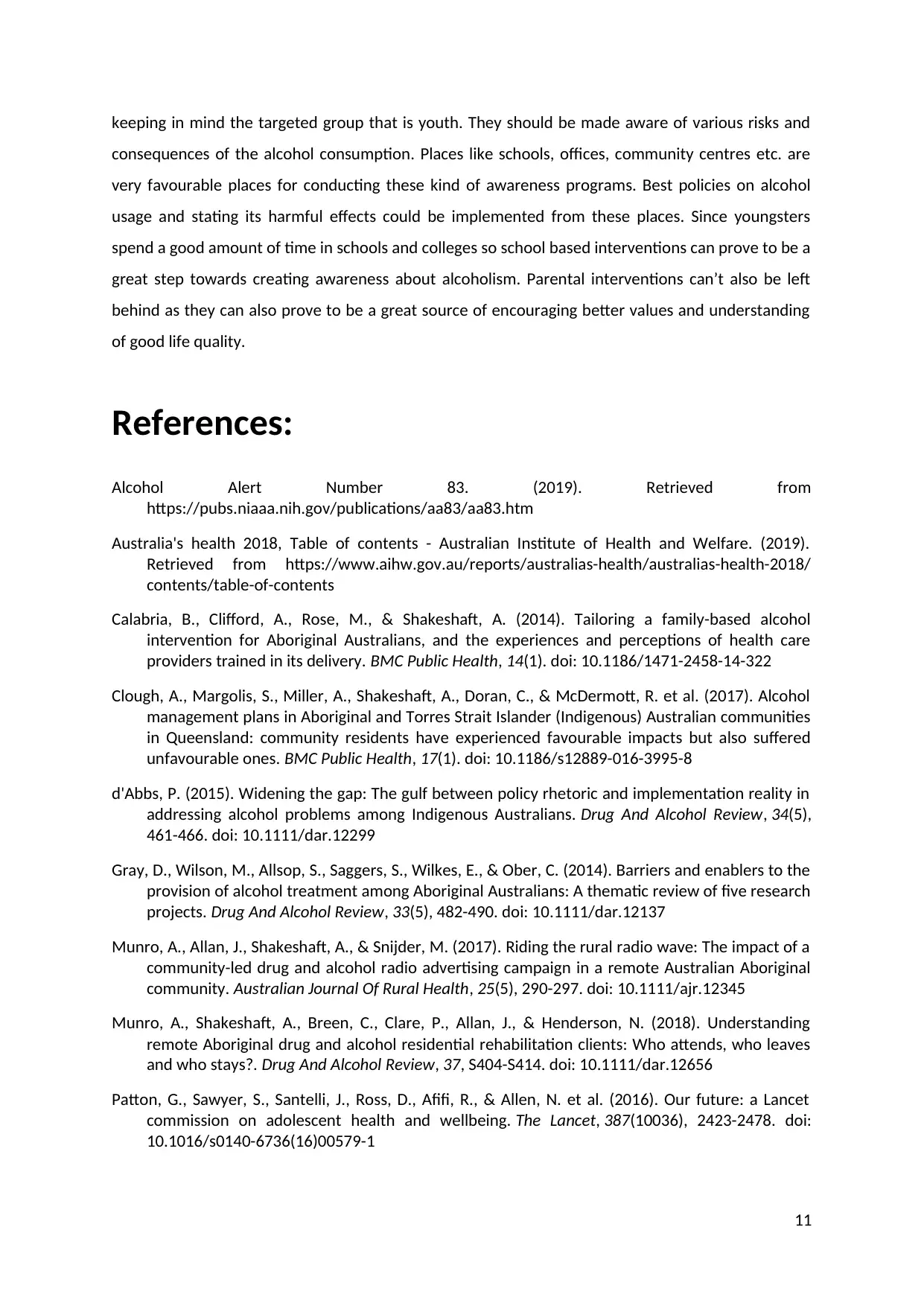
keeping in mind the targeted group that is youth. They should be made aware of various risks and
consequences of the alcohol consumption. Places like schools, offices, community centres etc. are
very favourable places for conducting these kind of awareness programs. Best policies on alcohol
usage and stating its harmful effects could be implemented from these places. Since youngsters
spend a good amount of time in schools and colleges so school based interventions can prove to be a
great step towards creating awareness about alcoholism. Parental interventions can’t also be left
behind as they can also prove to be a great source of encouraging better values and understanding
of good life quality.
References:
Alcohol Alert Number 83. (2019). Retrieved from
https://pubs.niaaa.nih.gov/publications/aa83/aa83.htm
Australia's health 2018, Table of contents - Australian Institute of Health and Welfare. (2019).
Retrieved from https://www.aihw.gov.au/reports/australias-health/australias-health-2018/
contents/table-of-contents
Calabria, B., Clifford, A., Rose, M., & Shakeshaft, A. (2014). Tailoring a family-based alcohol
intervention for Aboriginal Australians, and the experiences and perceptions of health care
providers trained in its delivery. BMC Public Health, 14(1). doi: 10.1186/1471-2458-14-322
Clough, A., Margolis, S., Miller, A., Shakeshaft, A., Doran, C., & McDermott, R. et al. (2017). Alcohol
management plans in Aboriginal and Torres Strait Islander (Indigenous) Australian communities
in Queensland: community residents have experienced favourable impacts but also suffered
unfavourable ones. BMC Public Health, 17(1). doi: 10.1186/s12889-016-3995-8
d'Abbs, P. (2015). Widening the gap: The gulf between policy rhetoric and implementation reality in
addressing alcohol problems among Indigenous Australians. Drug And Alcohol Review, 34(5),
461-466. doi: 10.1111/dar.12299
Gray, D., Wilson, M., Allsop, S., Saggers, S., Wilkes, E., & Ober, C. (2014). Barriers and enablers to the
provision of alcohol treatment among Aboriginal Australians: A thematic review of five research
projects. Drug And Alcohol Review, 33(5), 482-490. doi: 10.1111/dar.12137
Munro, A., Allan, J., Shakeshaft, A., & Snijder, M. (2017). Riding the rural radio wave: The impact of a
community-led drug and alcohol radio advertising campaign in a remote Australian Aboriginal
community. Australian Journal Of Rural Health, 25(5), 290-297. doi: 10.1111/ajr.12345
Munro, A., Shakeshaft, A., Breen, C., Clare, P., Allan, J., & Henderson, N. (2018). Understanding
remote Aboriginal drug and alcohol residential rehabilitation clients: Who attends, who leaves
and who stays?. Drug And Alcohol Review, 37, S404-S414. doi: 10.1111/dar.12656
Patton, G., Sawyer, S., Santelli, J., Ross, D., Afifi, R., & Allen, N. et al. (2016). Our future: a Lancet
commission on adolescent health and wellbeing. The Lancet, 387(10036), 2423-2478. doi:
10.1016/s0140-6736(16)00579-1
11
consequences of the alcohol consumption. Places like schools, offices, community centres etc. are
very favourable places for conducting these kind of awareness programs. Best policies on alcohol
usage and stating its harmful effects could be implemented from these places. Since youngsters
spend a good amount of time in schools and colleges so school based interventions can prove to be a
great step towards creating awareness about alcoholism. Parental interventions can’t also be left
behind as they can also prove to be a great source of encouraging better values and understanding
of good life quality.
References:
Alcohol Alert Number 83. (2019). Retrieved from
https://pubs.niaaa.nih.gov/publications/aa83/aa83.htm
Australia's health 2018, Table of contents - Australian Institute of Health and Welfare. (2019).
Retrieved from https://www.aihw.gov.au/reports/australias-health/australias-health-2018/
contents/table-of-contents
Calabria, B., Clifford, A., Rose, M., & Shakeshaft, A. (2014). Tailoring a family-based alcohol
intervention for Aboriginal Australians, and the experiences and perceptions of health care
providers trained in its delivery. BMC Public Health, 14(1). doi: 10.1186/1471-2458-14-322
Clough, A., Margolis, S., Miller, A., Shakeshaft, A., Doran, C., & McDermott, R. et al. (2017). Alcohol
management plans in Aboriginal and Torres Strait Islander (Indigenous) Australian communities
in Queensland: community residents have experienced favourable impacts but also suffered
unfavourable ones. BMC Public Health, 17(1). doi: 10.1186/s12889-016-3995-8
d'Abbs, P. (2015). Widening the gap: The gulf between policy rhetoric and implementation reality in
addressing alcohol problems among Indigenous Australians. Drug And Alcohol Review, 34(5),
461-466. doi: 10.1111/dar.12299
Gray, D., Wilson, M., Allsop, S., Saggers, S., Wilkes, E., & Ober, C. (2014). Barriers and enablers to the
provision of alcohol treatment among Aboriginal Australians: A thematic review of five research
projects. Drug And Alcohol Review, 33(5), 482-490. doi: 10.1111/dar.12137
Munro, A., Allan, J., Shakeshaft, A., & Snijder, M. (2017). Riding the rural radio wave: The impact of a
community-led drug and alcohol radio advertising campaign in a remote Australian Aboriginal
community. Australian Journal Of Rural Health, 25(5), 290-297. doi: 10.1111/ajr.12345
Munro, A., Shakeshaft, A., Breen, C., Clare, P., Allan, J., & Henderson, N. (2018). Understanding
remote Aboriginal drug and alcohol residential rehabilitation clients: Who attends, who leaves
and who stays?. Drug And Alcohol Review, 37, S404-S414. doi: 10.1111/dar.12656
Patton, G., Sawyer, S., Santelli, J., Ross, D., Afifi, R., & Allen, N. et al. (2016). Our future: a Lancet
commission on adolescent health and wellbeing. The Lancet, 387(10036), 2423-2478. doi:
10.1016/s0140-6736(16)00579-1
11
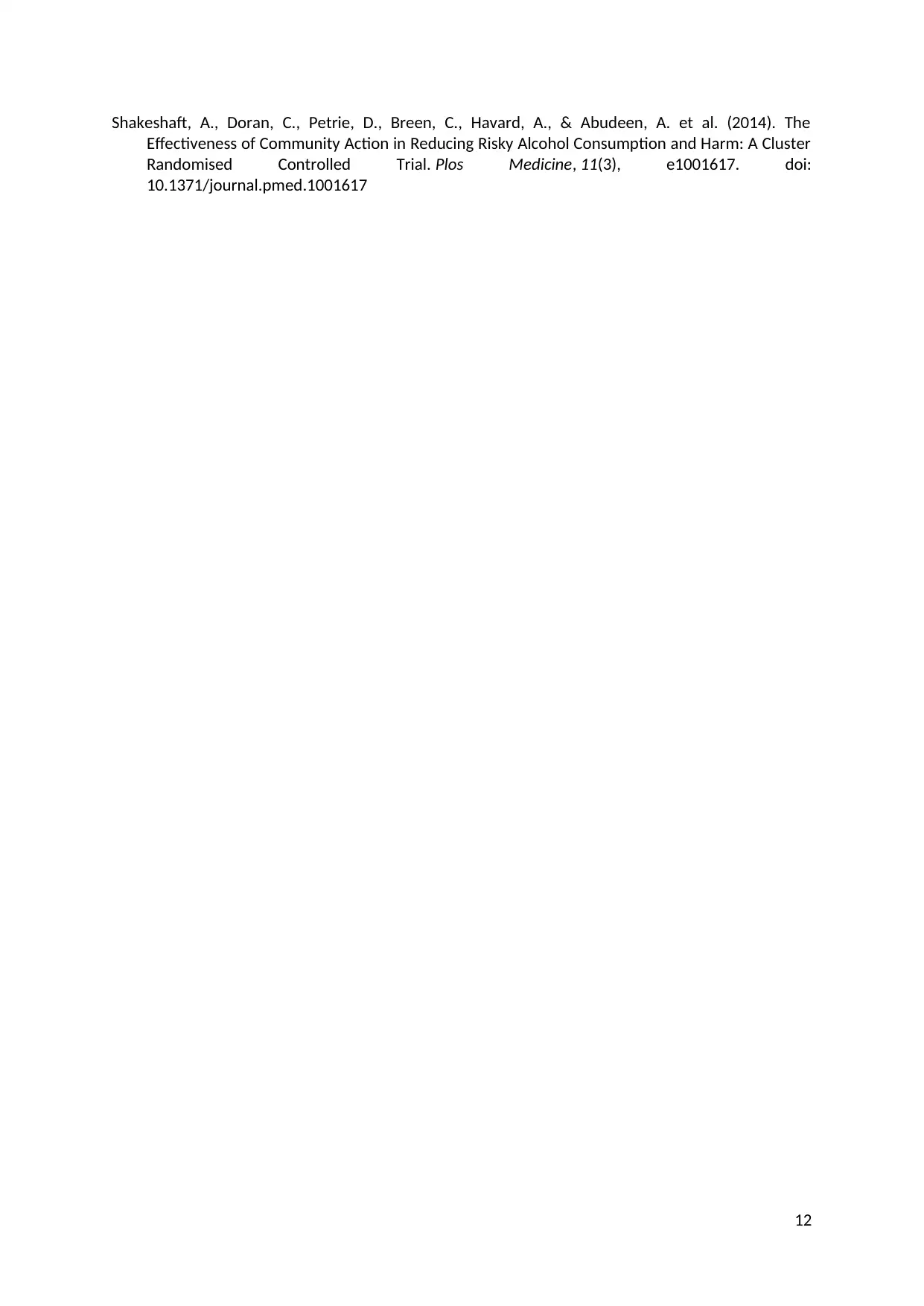
Shakeshaft, A., Doran, C., Petrie, D., Breen, C., Havard, A., & Abudeen, A. et al. (2014). The
Effectiveness of Community Action in Reducing Risky Alcohol Consumption and Harm: A Cluster
Randomised Controlled Trial. Plos Medicine, 11(3), e1001617. doi:
10.1371/journal.pmed.1001617
12
Effectiveness of Community Action in Reducing Risky Alcohol Consumption and Harm: A Cluster
Randomised Controlled Trial. Plos Medicine, 11(3), e1001617. doi:
10.1371/journal.pmed.1001617
12
1 out of 12
Related Documents
Your All-in-One AI-Powered Toolkit for Academic Success.
+13062052269
info@desklib.com
Available 24*7 on WhatsApp / Email
![[object Object]](/_next/static/media/star-bottom.7253800d.svg)
Unlock your academic potential
© 2024 | Zucol Services PVT LTD | All rights reserved.



